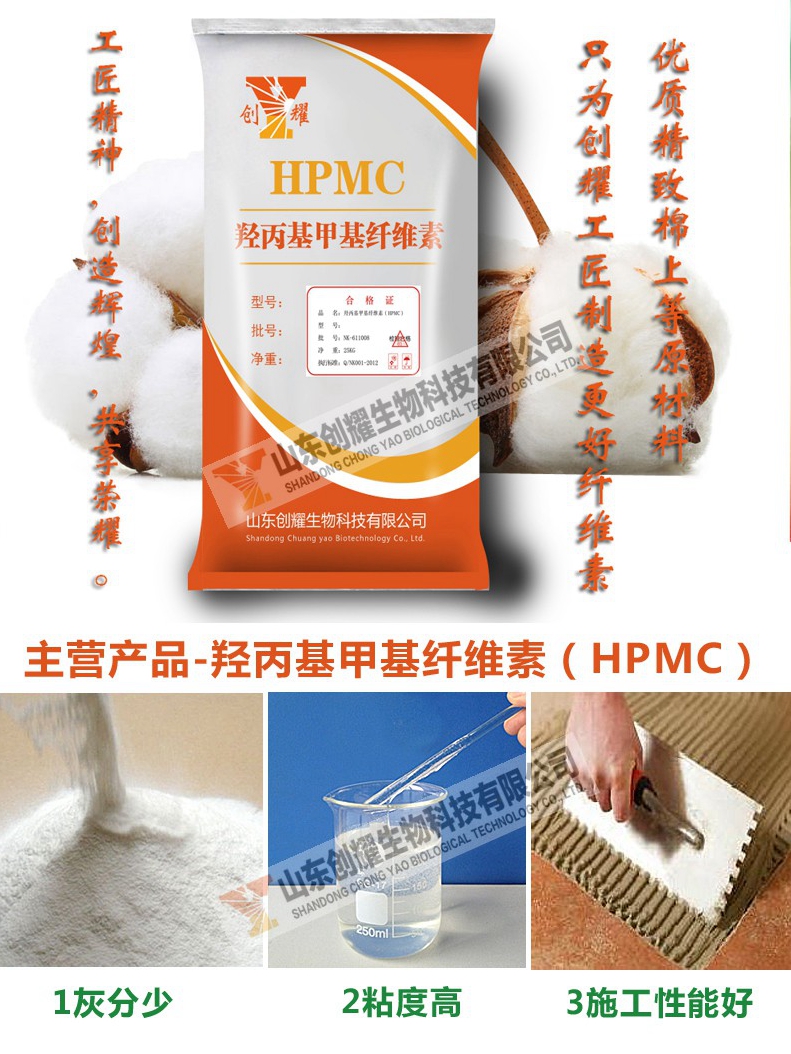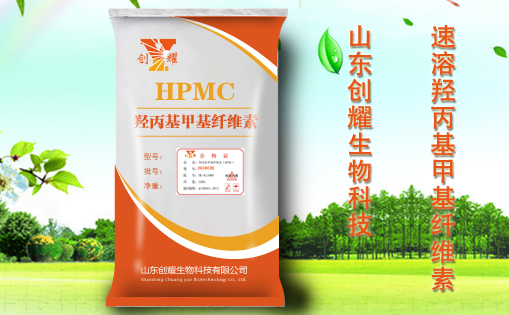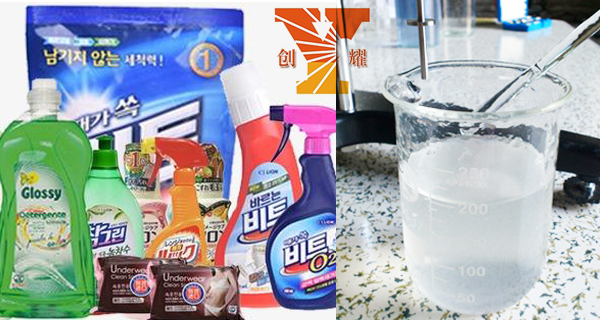One minute to learn about hydroxypropyl methylcellulose HPMC
Shandong chuangyao Biotechnology Co., Ltd. briefly summarizes the knowledge of hydroxypropyl methylcellulose products.
1. What are the main uses of hydroxypropyl methylcellulose (HPMC)?

HPMC is widely used in building materials, coatings, synthetic resin, ceramics, medicine, food, textile, agriculture, cosmetics, tobacco and other industries. HPMC can be divided into: construction grade, food grade and pharmaceutical grade. At present, most domestic products are of construction grade. In the construction grade, the amount of putty powder is very large, about 90% is used as putty powder, and the rest is used as cement mortar.
2. How does hydroxypropyl methylcellulose (HPMC) smell?
HPMC produced by solvent method uses toluene and isopropanol as solvent. If it is not washed well, there will be some residual taste.
3. What are the dissolution methods of hydroxypropyl methylcellulose (HPMC)?
Hot water dissolution method: since HPMC does not dissolve in hot water, HPMC can be evenly dispersed in hot water at the initial stage, and then quickly dissolved when cooled. Two typical methods are described as follows:
1) Put the required amount of hot water into the container and heat it to about 70 ℃. Hydroxypropyl methylcellulose was gradually added under slow stirring, HPMC began to float on the surface of water, and then gradually formed a slurry, which was cooled under stirring.
2) Add 1 / 3 or 2 / 3 of the required amount of water into the container and heat it to 70 ℃, disperse HPMC according to the method of 1) to prepare hot water slurry; Then add the remaining amount of cold water to the hot water slurry, stir and cool the mixture. Powder mixing method: mix HPMC powder with a large number of other powdery materials in a mixer, and then add water to dissolve it. At this time, HPMC can dissolve without agglomeration, because there is only a little HPMC powder in each tiny corner, which will dissolve immediately in case of water—— Putty powder and mortar manufacturers use this method. [hydroxypropyl methylcellulose (HPMC) is used as thickener and water retaining agent in putty powder mortar.
4. How to judge the quality of hydroxypropyl methylcellulose (HPMC) simply and intuitively?
(1) Whiteness: Although whiteness cannot determine whether HPMC is easy to use, if whitening agent is added in the production process, its quality will be affected. However, most good products have good whiteness.
(2) Fineness: the fineness of HPMC is generally 80 mesh and 100 mesh, less 120 mesh. Most HPMC produced in Hebei are 80 mesh. The finer the fineness, the better in general.
(3) Light transmittance: put hydroxypropyl methylcellulose (HPMC) into water to form a transparent colloid, and look at its transmittance. The greater the light transmittance, the better, indicating that there are less insoluble substances in it. The permeability of vertical reactors is generally good, while that of horizontal reactors is worse, but it does not mean that the production quality of vertical reactors is better than that of horizontal reactors. There are many factors determining the product quality.
(4) Specific gravity: the greater the specific gravity, the heavier it is better. It is generally because the content of hydroxypropyl is high. If the content of hydroxypropyl is high, the water retention is better.
5. What is the difference between the cold water instant type and the heat soluble type of hydroxypropyl methyl cellulose in the production process?
The rapid dispersion type of HPMC is subject to glyoxal surface treatment. It is rapidly dispersed in cold water, but it is not really dissolved. It is dissolved only when the viscosity is up. The instant type is not surface treated with glyoxal. When glyoxal is in large volume, it will disperse quickly, but the viscosity will rise slowly. When glyoxal is in small volume, it will be the opposite.
6. What is the appropriate viscosity of hydroxypropyl methylcellulose (HPMC)?
Putty powder is generally 100000. The requirements in mortar are higher. It takes 150000 to be easy to use. Moreover, the most important role of HPMC is water retention, followed by thickening. In putty powder, as long as the water retention is good and the viscosity is lower (70000-80000), it is also OK. Of course, the higher the viscosity, the better the relative water retention. When the viscosity exceeds 100000, the viscosity has little effect on the water retention.
7. What are the main technical indexes of hydroxypropyl methylcellulose (HPMC)?
Hydroxypropyl content and viscosity, most people are concerned about these two indicators. Water retention is generally better for those with high hydroxypropyl content. Those with high viscosity and water retention are relatively (but not absolutely) better, and those with high viscosity are better used in cement mortar.

8. What are the main raw materials of hydroxypropyl methylcellulose (HPMC)?
The main raw materials of hydroxypropyl methylcellulose (HPMC): refined cotton, methyl chloride and propylene oxide. Other raw materials include flake alkali, acid, toluene, isopropanol, etc.
9. What is the main role of HPMC in the application of putty powder and whether there is chemical reaction?
HPMC plays three roles in the of putty powder: thickening, water retention and construction.
Thickening: cellulose can be thickened, play the role of suspension, keep the solution uniform up and down, and resist sagging.
Water retention: make the putty powder dry slowly and assist the reaction of ash calcium under the action of water.
Construction: cellulose has lubricating effect, which can make the putty powder have good workability.
Adding water to the putty powder and putting it on the wall is a chemical reaction. Because new substances are generated, the putty powder on the wall can be removed from the wall, ground into powder, and then reused, because new substances (calcium carbonate) have been formed.
The main components of ash calcium powder are the mixture of Ca (OH) 2, Cao and a small amount of CaCO3. CaO + H2O = Ca (OH) 2 - Ca (OH) 2 + CO2 = CaCO3 ↓ + H2O ash calcium generates calcium carbonate under the action of CO2 in water and air, while HPMC only keeps water and assists ash calcium in better reaction. It itself does not participate in any reaction.
10. HPMC is a non-ionic cellulose ether, so what is non-ionic?
Generally speaking, non ions are substances that will not ionize in water. Ionization refers to the process in which an electrolyte is dissociated into free moving charged ions in a specific solvent (such as water and alcohol). For example, the daily salt sodium chloride (NaCl) is dissolved in water and ionized to produce free moving sodium ions (Na +) with positive charge and chloride ions (CL) with negative charge. In other words, HPMC in water will not dissociate into charged ions, but exist in the form of molecules.
11. What is the gel temperature of hydroxypropyl methyl cellulose?
The gel temperature of HPMC is related to its methoxy content. The lower the methoxy content, the higher the gel temperature.
12. Is there any relationship between powder dropping of putty powder and HPMC?
The powder dropping of putty powder is mainly related to the quality of ash calcium, but not to HPMC. The low calcium content of ash calcium and the inappropriate proportion of Cao and Ca (OH) 2 in ash calcium will cause powder loss. If it has something to do with HPMC, the poor water retention of HPMC will also cause powder loss.
13. What is the difference between the cold water instant type and the heat soluble type of hydroxypropyl methyl cellulose in the production process?

The rapid dispersion type of HPMC is subject to glyoxal surface treatment. It is rapidly dispersed in cold water, but it is not really dissolved. It is dissolved only when the viscosity is up. The instant type is not surface treated with glyoxal. When glyoxal is in large volume, it will disperse quickly, but the viscosity will rise slowly. When glyoxal is in small volume, it will be the opposite.
For more information on hydroxypropyl methylcellulose products, please pay attention to Shandong chuangyao Biotechnology Co., Ltd.
{aspcms:comment}





